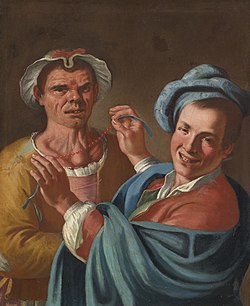
Back Femminielli Catalan Femminiello Spanish Femminielli French Femminiello Galician Femminiello Croatian Femminiello Italian Femmeniello NAP Femminiello Portuguese Фемминиелли Russian Femminiello SIMPLE
This article's tone or style may not reflect the encyclopedic tone used on Wikipedia. (October 2024) |

| Part of a series on |
| Transgender topics |
|---|
|
|
Femminielli or femmenielli (singular femminiello, also spelled as femmeniello) are a population of people who embody a third gender role in traditional Neapolitan culture.[4][5] This term is culturally distinct from trans woman, and has its own cultural significance and practices, often including prostitution.[5] This term is not derogatory; instead femminielli are traditionally believed to bring good luck.[4][5]
- ^ "The Femminiello". portlandartmuseum.us. Retrieved 2024-07-28.
- ^ "Naples Life,Death & Miracle". www.naplesldm.com. Retrieved 2024-07-28.
- ^ Lang, Nico (11 Jul 2016). "This 18th-Century Italian Painting Proves Gender Nonconformity Is Far From a Modern Invention". Slate. The Slate Group LLC.
- ^ a b Fulvio, Bufi (2009). "Presa Ketty, boss "femminiello" Comandava i pusher di Gomorra". Corriere della Sera (February 13, 2009): 19. Archived from the original on September 14, 2015.
Femminiello è una figura omosessuale (..) è una persona dall' aspetto effeminato o spesso un travestito. È rispettato e generalmente il femminiello viene considerato una persona che porta fortuna.
- ^ a b c Jeff Matthews. "The Femminiello in Neapolitan Culture". Archived from the original on 2011-05-15.